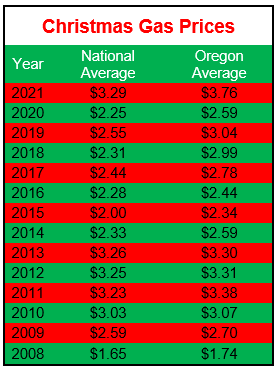
Holiday shoppers may have a little more jingle in their pockets thanks to plunging pump prices. All 50 states are seeing prices fall again this week with declines ranging from three to 21 cents. For the week, the national average for regular drops 13 cents to $3.12 a gallon. The Oregon average slides 16 cents to $3.82. Oregon has the ninth-largest weekly drop and fifth-largest monthly drop for a state in the nation.

The national average is at its lowest price since July 2021 and the Oregon average is at its lowest price since last January. The national average is poised to drop below $3 a gallon by the end of the year.
The cost of crude oil has been hovering in the low-to-mid $70s per barrel, and that’s $50 less than the peak last June,” says Marie Dodds, public affairs director for AAA Oregon/Idaho. “Combined with low seasonal demand, gas prices could slide a bit more before leveling off.”
Gas prices are similar to last year with the national and Oregon averages within about 20 cents per gallon of last year’s averages.
AAA projects a busy holiday travel season with 112.7 million Americans including 1.6 million Oregonians traveling for the holidays. 2022 is expected to be the third-busiest year for holiday travel since 2000, trailing only 2019 and 2019.
Find all the details, graphics and tips for travelers in the AAA holiday travel news release.

Earlier this month, West Texas Intermediate, the U.S. benchmark, fell below $72 per barrel, the lowest price since December 2021, and has remained between about $71.50 and $81 this month. In November, WTI ranged between $76 and $92 per barrel. In October, crude ranged between $82 and $92 per barrel. In September, crude prices ranged between about $76 and $88 per barrel. Crude reached a recent high of $122.11 per barrel on June 8. The all-time high for WTI crude oil is $147.27 in July 2008.
Crude prices rose dramatically leading up to and in the first few months of Russia’s invasion of Ukraine. Russia is one of the world’s top oil producers and its involvement in a war causes market volatility, and sanctions imposed on Russia by the U.S. and other western nations resulted in tighter global oil supplies. Oil supplies were already tight around the world as demand for oil increased as pandemic restrictions eased. A year ago, crude was around $70 per barrel compared to $76 today.
Crude oil is the main ingredient in gasoline and diesel, so pump prices are impacted by crude prices on the global markets. On average, about 56% of what we pay for in a gallon of gasoline is for the price of crude oil, 20% is refining, 11% distribution and marketing, and 14% are taxes, according to the U.S. Energy Information Administration.
Demand for gasoline in the U.S. declined slightly from 8.36 to 8.26 million b/d for the week ending December 9. This compares to 9.47 million b/d at this time last year. Total domestic gasoline stocks rose significantly by 4.5 million bbl to 223.6 million bbl. Increasing supply and lower gasoline demand should continue to put downward pressure on pump prices, barring any supply glitches.
Quick stats
Pump prices are lower this week in all 50 states and the District of Columbia. Nevada (-21 cents) has the largest weekly drop, followed by Indiana (-20 cents), and Arizona (-19 cents). Oregon (-16 cents) has the ninth-largest weekly drop. Hawaii (-3 cents) has the smallest weekly decline.
Hawaii ($5.11) is the state with the most expensive gas in the nation for the fourth week in a row and is the only state with an average at or above $5 a gallon. California ($4.36) is second and Nevada ($4.03) is third. These are the only three states with averages at or above $4 a gallon. This week 25 states and the District of Columbia have averages in the $3-range, and 22 states have averages below $3 a gallon.
The cheapest gas in the nation is in Texas ($2.61) and Oklahoma ($2.65). For the 101st week in a row, no state has an average below $2 a gallon.
The difference between the most expensive and least expensive states is $2.51 which continues to be stark.
All 50 states and the District of Columbia have lower prices now than a month ago. The national average is 55 cents less and the Oregon average is 82 cents less than a month ago. Oregon has the fifth-largest monthly decrease in the nation. California (-91 cents) and Alaska (-90 cents) have the largest monthly declines. Hawaii (-8 cents) has the smallest.
Oregon is one of 11 states with higher prices now than a year ago. The national average is 19 cents less and the Oregon average is five cents more than a year ago. This is the sixth-largest year-over-year increase in the nation. Hawaii (+78 cents), Nevada (+17 cents), and Pennsylvania (+11 cents) have the largest yearly gains. Colorado (-48 cents) has the biggest year-over-year decline.















